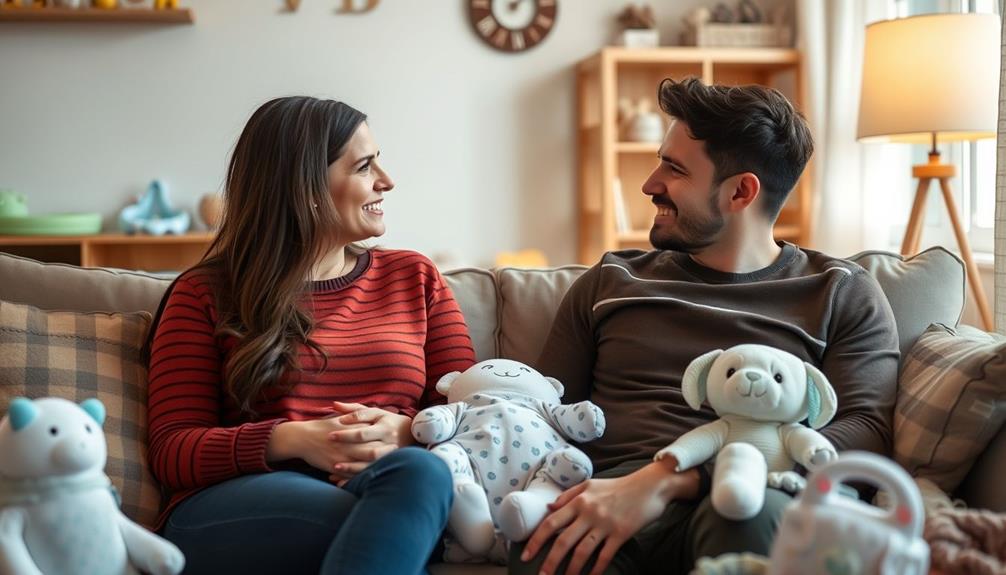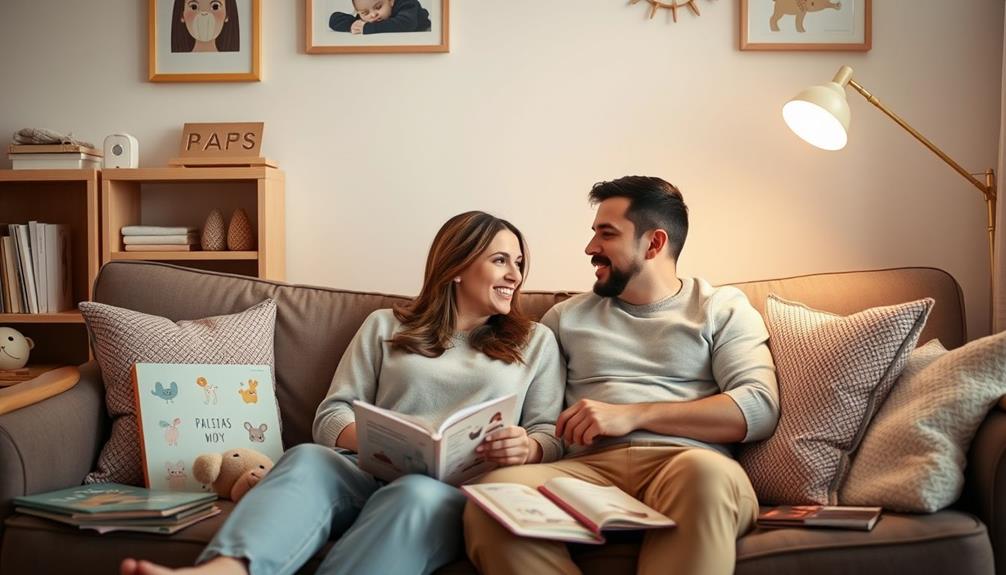Starting relationship changes when planning for a baby can be challenging but rewarding. You'll need to communicate openly about roles and expectations, ensuring you're both on the same page. Regular check-ins can help manage the emotional ups and downs. Don't forget to address intimacy changes and sleep challenges, too, as they can affect your connection. Strengthening your support system can lighten the load. Planning for financial responsibilities upfront will prevent added stress. As you begin this journey together, understanding these dynamics can set the stage for success—there's more to explore on making this change smoother together.
Key Takeaways
- Openly discuss and establish clear roles and responsibilities to ensure alignment between partners during the transition to parenthood.
- Schedule regular check-ins to address emotional needs, household tasks, and intimacy, fostering honest communication and connection.
- Create a detailed budget and financial plan to manage the significant costs associated with raising a child and unexpected expenses.
- Build a strong support system by organizing meal trains, hiring help, and connecting with local resources to ease postpartum challenges.
- Seek professional support through workshops or counseling to enhance communication strategies and navigate relationship dynamics effectively.
Understanding New Roles
As you step into parenthood, it's critical to recognize how your roles might shift. Traditionally, mothers often assume nurturing responsibilities while fathers provide support, but many modern couples are embracing shared duties to foster teamwork. This collaboration not only strengthens your bond but also sets a positive example for your child, especially when considering astrological compatibility and its effects on attraction.
If you're in a same-sex relationship, you may find yourselves redefining parenting roles without established models. In this case, mutual understanding and open communication are essential as you navigate your new responsibilities together. Establishing clear roles for delivery room attendees and family gatherings helps define expectations, reducing tension among family members as you adapt to this alteration.
It's also important to present a united front to in-laws and set clear boundaries for family interactions. This approach can guarantee compliance and minimize stress during this shift.
Effective Communication Strategies

To navigate the changes that come with a baby, it's essential to share your expectations openly with your partner.
Regular check-ins allow both of you to express emotional needs and discuss household responsibilities, fostering a stronger bond.
Incorporating support strategies, such as those found in mental health support, can also enhance your communication.
Encouraging emotional vulnerability creates a safe space for honest conversations, helping you both adjust together.
Share Expectations Openly
Sharing expectations openly is essential when preparing for a baby, as it lays the foundation for a supportive partnership. Clear communication about parenting roles and household responsibilities can greatly reduce misunderstandings. By discussing these important things together, you foster teamwork and guarantee that both you and your partner are on the same page.
Make it a priority to share your thoughts and feelings regarding what you envision for your new family dynamic. This might include preferences around parenting styles, division of chores, or how to handle extended family involvement.
Establishing boundaries in these areas can prevent conflicts and reinforce a united front, which is significant for maintaining a healthy relationship with your partner.
Consider using communication tools like apps or dedicated family meetings to facilitate these discussions. This structured approach can help keep the lines of communication open, allowing you both to express concerns and celebrate successes.
Regular Check-Ins Essential
Regular check-ins between partners are essential for steering through the complexities of new parenthood. These discussions help guarantee alignment on parenting roles and responsibilities, reducing misunderstandings and conflicts. Establishing a routine for regular check-ins fosters open communication, allowing both of you to express your needs and expectations clearly.
Here's a simple table to guide your check-ins:
| Frequency | Topics to Discuss | Tools to Use |
|---|---|---|
| Weekly | Parenting roles | Relationship apps |
| Bi-weekly | Emotional intimacy | Shared calendars |
| Monthly | Quality time and connection | Journals or notes |
Engaging in frequent communication not only helps you stay on the same page but also maintains emotional intimacy, which can decline during this shift. Consistent check-ins provide a chance to address feelings of neglect or resentment, especially as one partner may focus more on the baby. By prioritizing these moments together, you strengthen your bond and guarantee both partners feel valued and heard.
Encourage Emotional Vulnerability
Building on the importance of check-ins, encouraging emotional vulnerability can considerably enhance your connection during parenthood. Creating a safe space for both of you to express your thoughts and feelings is essential. Discuss your fears, hopes, and expectations about becoming parents; this openness fosters understanding and strengthens your bond.
Regularly scheduled check-ins facilitate these open discussions, allowing you to address feelings and concerns before they escalate into miscommunication. Practice active listening by reflecting back what you hear and validating each other's feelings. This technique not only enhances emotional intimacy but also reduces misunderstandings.
Sharing personal experiences can reinforce trust and help you navigate relationship changes together as a couple. Consider utilizing tools like communication apps or journaling to articulate your thoughts and feelings more clearly. These methods promote ongoing dialogues about your emotional states and relationship dynamics, ensuring you stay connected during this significant shift.
Ultimately, by prioritizing emotional vulnerability, you cultivate a deeper connection that can withstand the challenges of parenthood. Embrace this journey together, and you'll emerge stronger as partners and parents.
Managing Sleep Challenges

Managing sleep challenges as new parents can feel overwhelming, but establishing a nighttime plan can make a substantial difference. Sleep deprivation impacts your cognitive function and emotional stability, so it's essential to tackle this issue together.
Consider incorporating effective weight loss strategies that promote better sleep quality, as maintaining a healthy weight can enhance overall well-being. Start by communicating openly about your sleep needs and preferences. This guarantees both you and your partner feel supported during this challenging time.
Creating a consistent sleep routine for your baby is critical. A well-established bedtime routine can help your little one settle down, giving you much-needed pockets of rest.
Consider taking shifts for nighttime duties; sharing responsibilities can greatly reduce fatigue and irritability. When you both recharge, you strengthen your connection, making it easier to navigate this new chapter in your life.
Navigating Intimacy Changes

As you navigate the changes that come with early parenthood, open communication about intimacy becomes essential.
Authenticity is key when discussing your feelings and concerns, as it can help both partners feel more secure in sharing their thoughts.
Reassessing your physical connections can help you both understand each other's needs and desires during this time.
Open Communication About Intimacy
Maneuvering the complexities of intimacy after having a baby can be intimidating, but open communication serves as an essential lifeline for couples.
It's important to acknowledge that many of you might experience a decline in sexual intimacy due to exhaustion, hormonal changes, and shifts in priorities. Sharing those feelings openly helps normalize the experience and paves the way for deeper understanding.
You may find that a lack of sleep contributes to feelings of disinterest in sex, making it vital to discuss your sexual needs with your partner.
Establishing regular check-ins about intimacy allows both of you to express your feelings and desires without fear of judgment. This practice fosters understanding and can prevent feelings of neglect that might arise during the early parenting phase.
Don't forget that exploring alternative forms of intimacy and connection, such as engaging in shared activities or simply cuddling, can strengthen your emotional bond.
Reassessing Physical Connections
Open communication about intimacy sets the stage for reassessing physical connections after the arrival of your baby. As new parents, you may notice a decline in intimacy due to physical recovery, hormonal changes, and emotional exhaustion.
It's vital to discuss your sexual needs openly to maintain a healthy relationship. Studies reveal that around 60% of new parents experience decreased sexual intimacy in the first year postpartum, making dialogue essential.
Women often prioritize baby care, driven by biological instincts, which can lead to feelings of neglect or frustration in their partners if unaddressed. Regular check-ins about intimacy help you navigate these feelings of disconnection.
Research shows couples who maintain open communication about their sexual relationship report higher satisfaction levels.
To foster emotional connection and intimacy amidst the challenges of new parenthood, consider engaging in shared activities and exploring each other's love languages.
These efforts can strengthen your bond, reminding you both that intimacy isn't solely physical; it can be emotional and affectionate as well.
Financial Planning Essentials

Planning for a new baby requires a thoughtful approach to finances, especially when you consider the added expenses that come with parenthood.
It's important to create a detailed budget that accounts for essentials like diapers, formula, and healthcare. On average, raising a child in the U.S. can exceed $230,000 from birth to age 18, underscoring the need for early financial planning.
Additionally, consider evaluating your home environment to guarantee it's safe and welcoming for your newborn, which may involve costs for home cleaning services like key factors in choosing a home cleaning service.
Start by evaluating your current financial situation.
Look at your income, savings, and debts to establish a clear plan for managing the additional expenses that come with being a parent. Setting up an emergency fund of at least three to six months' worth of living expenses is essential.
This safety net can help you tackle unexpected costs during pregnancy and after your baby arrives.
Building Your Support System

As you prepare for your baby's arrival, building a strong support system can make a world of difference. Research shows that having a network of family members and friends enhances your emotional well-being and reduces stress. This support is especially important during times of major life changes, such as navigating divorce, which can add additional layers of complexity to parenthood.
Start by organizing meal trains or cooking support from loved ones during the postpartum period. This assistance allows you to focus on bonding with your new baby without the burden of daily tasks.
Consider hiring professional help, like cleaning services, in those early months. This frees up your time to adapt and connect with your little one without the stress of household chores.
Identifying local postpartum resources, such as parenting groups or counseling services, can create a safety net for you, fostering a sense of community and shared experience.
Don't forget to create an "everything list" to delegate household tasks among family and friends. This guarantees a balanced distribution of responsibilities, which can help maintain your mental health and relationship stability during the demanding early stages of parenting.
With the right support system in place, you can navigate this change more smoothly, allowing for more meaningful time together as a new family.
Impact of Parenthood on Relationships

The arrival of a baby reshapes relationships in profound ways, often introducing new dynamics and challenges for couples. First childbirth can greatly alter how you and your partner interact, often leading to increased stress and conflict.
You may find yourselves managing the demands of parenthood, which can strain your relationship. Open communication becomes essential. It's important to talk openly about your feelings, especially as one parent may feel neglected due to the time and attention the baby requires.
During this period, maintaining a healthy lifestyle, including safe second trimester workouts, can also help manage stress and improve overall well-being.
The early months can be overwhelming, so regular check-ins about caregiving roles are significant. If you notice feelings of resentment or neglect arising, don't hesitate to reach out for professional help, like counseling. This can provide you with effective strategies to address difficulties that emerge post-birth.
Additionally, increased involvement of grandparents and other family members can shift family dynamics further, influencing your relationship.
Preparing for Parenthood Transition

Before your baby arrives, preparing for the shift to parenthood is essential for both you and your partner. You need to talk openly about your expectations regarding roles, responsibilities, and emotional needs. This dialogue will help you both know what to expect and foster a supportive environment during this change.
Engaging in creative family activities can also enhance your partnership and set a positive tone for your parenting journey, as it encourages collaboration and innovation in your new roles family activities that promote creativity.
It's important to discuss how intimacy and relationship dynamics might change once you become parents. Engaging in these discussions now can ease the emotional landscape you'll navigate later.
Establishing a support network with family, friends, and parenting groups can also provide valuable resources as you begin this journey.
Sleep might become a significant challenge, so creating a nighttime plan to share responsibilities is essential. Anticipating the impact of sleep deprivation on your relationship will help you approach it with empathy and understanding.
Regular check-ins about parenting roles will strengthen your emotional connection and prevent misunderstandings.
Seeking Professional Support

Steering through the emotional landscape of parenthood can be overwhelming, and seeking professional support can make a significant difference. Engaging with trained professionals, like counselors, offers tailored advice to help you navigate the relational changes during pregnancy and early parenthood. This proactive measure can enhance your communication strategies, address conflicts, and strengthen emotional connections.
Here's a quick overview of the benefits of professional support:
| Benefit | Description |
|---|---|
| Tailored Advice | Get personalized strategies to manage relationship changes. |
| Healthy Communication | Learn effective communication strategies to reduce misunderstandings. |
| Conflict Resolution | Address conflicts constructively before they escalate. |
| Shared Experiences | Join workshops or support groups to connect with others facing similar challenges. |
| Role Discussions | Facilitate discussions about expectations and intimacy post-baby. |
Recognizing the importance of accessing professional support can help you better manage stress and improve relationship dynamics as you shift into parenthood. Embrace this opportunity to strengthen your partnership during this transformative time.
Frequently Asked Questions
How Can We Maintain Our Individual Identities While Preparing for Parenthood?
Maintaining your individual identities during big life changes can be challenging but essential. You can set aside regular time for your personal interests, whether it's pursuing hobbies, spending time with friends, or just enjoying some quiet time alone.
Communicate openly with your partner about your needs and support each other's pursuits. By prioritizing both your identities and your relationship, you'll create a balanced foundation as you prepare for the exciting journey ahead.
What Activities Can We Do Together to Strengthen Our Relationship Before the Baby Arrives?
Before your world turns upside down, it's wise to savor the quiet moments together.
You can explore new hobbies, take dance classes, or enjoy cozy movie nights. Cooking meals together can be a fun way to bond, while outdoor adventures might breathe fresh air into your connection.
Don't forget to set aside time for deep conversations; they'll help you both grow closer and strengthen your relationship before life gets a little busier.
How Do We Handle Disagreements About Parenting Styles During Pregnancy?
Handling disagreements about parenting styles during pregnancy can feel challenging, but open communication is key.
Start by discussing your views honestly, without judgment. Listen to each other's perspectives, and try to find common ground.
It's important to compromise and be flexible, as you both will need to adapt. Consider setting aside time for joint decision-making, which can strengthen your partnership.
What Resources Are Available for Expectant Parents to Improve Their Relationship?
As expectant parents, you've got plenty of resources at your fingertips to strengthen your relationship.
Consider attending prenatal classes together, which can help you bond and share experiences. Books on parenting and communication can also provide valuable insights.
Don't overlook online forums or support groups, where you can connect with others facing similar challenges.
How Can We Keep the Romance Alive During This Transitional Period?
When the going gets tough, keeping the romance alive can feel challenging. You can sprinkle little surprises into your routine, like spontaneous date nights or heartfelt notes.
Communicate openly about your feelings and desires, making sure to listen just as much.
Prioritize quality time, turning mundane moments into cherished memories.
Conclusion
As you commence this wild journey of parenthood, remember that steering through relationship changes is like sailing through a storm—exciting yet intimidating! Embrace new roles, communicate like pros, and tackle sleep challenges with superhero resilience. Don't forget to manage intimacy and finances, and build your fortress of support. Parenthood might rock your world, but with preparation and a sprinkle of humor, you're not just surviving; you're thriving! So, buckle up, because this adventure is just beginning!










